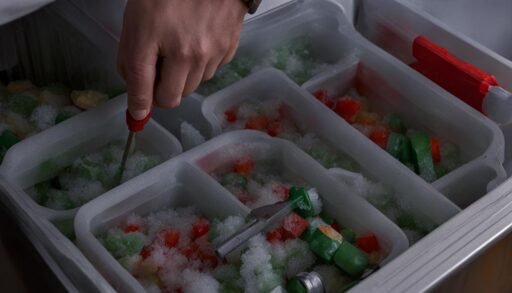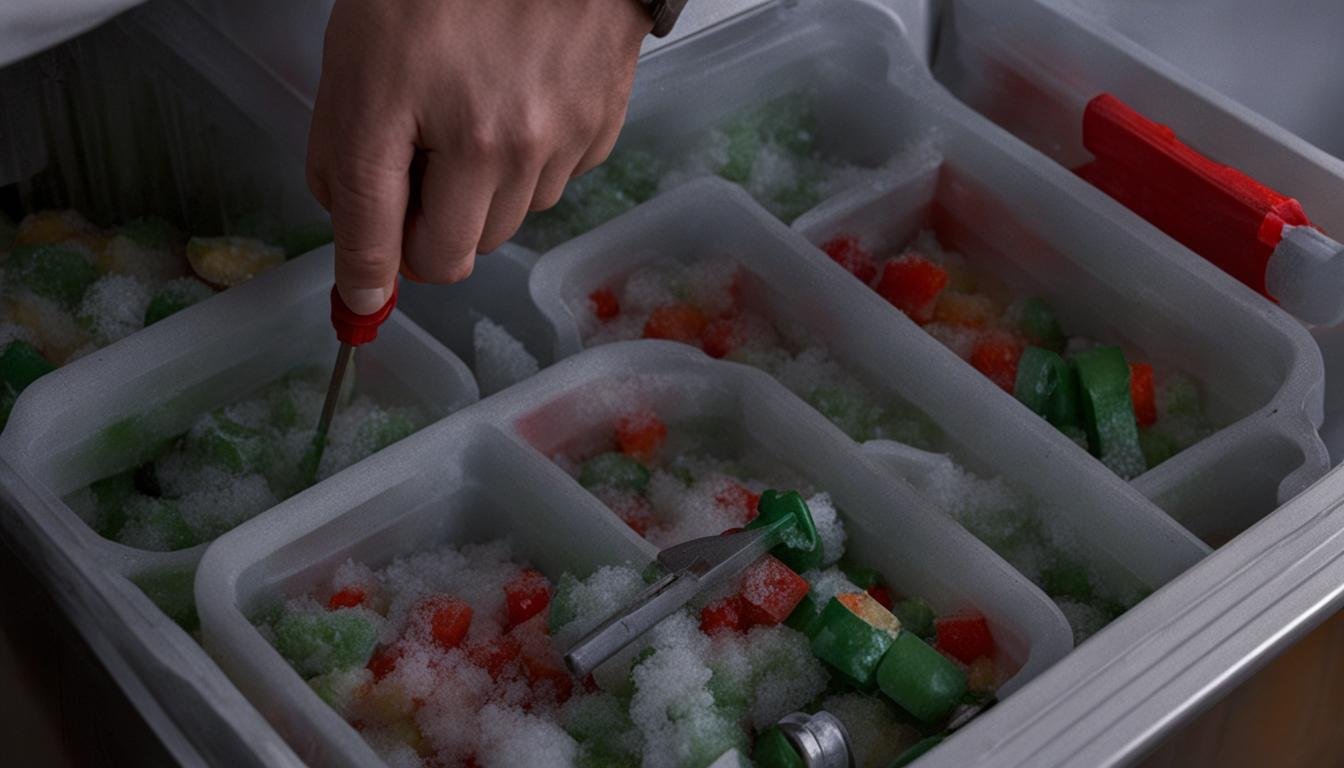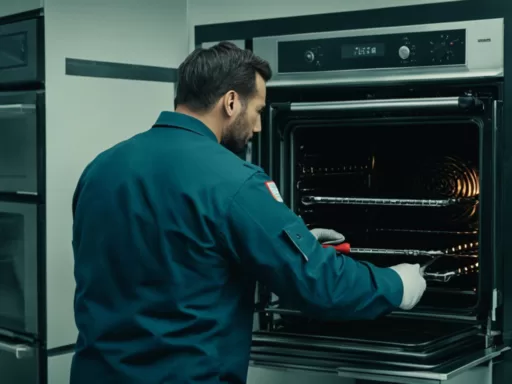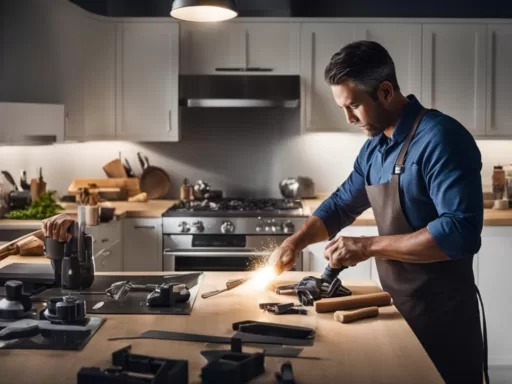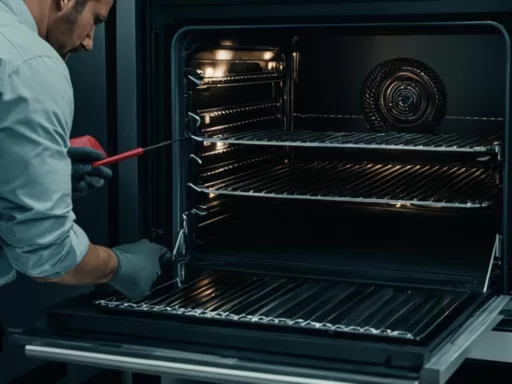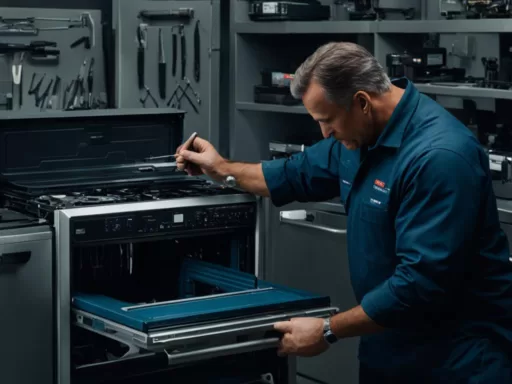When it comes to maintaining your Sub-Zero appliances, understanding how to troubleshoot and fix common issues can save you time and money. Whether you’re dealing with a refrigerator, freezer, or ice maker problem, having expert strategies at your disposal can help you resolve the issue effectively. In this comprehensive guide, we’ll provide you with essential tips and techniques for troubleshooting and repairing your Sub-Zero devices.
Key Takeaways:
- Learn how to troubleshoot and fix common issues with Sub-Zero appliances
- Save time and money by resolving problems on your own
- Provide valuable information to a technician if needed
- Follow expert strategies to ensure effective repairs
- Maintain your Sub-Zero appliances for long-lasting performance
Troubleshooting a Refrigerator That Isn’t Cooling
When it comes to Sub-Zero refrigerator repair, one of the most common issues you may encounter is when it’s not cooling properly. This can be a cause for concern as it can lead to spoiled food and inconvenience. However, before calling a technician, there are a few troubleshooting steps you can take to try and resolve the problem yourself.
The first thing to check is the condenser coils. Over time, these coils can accumulate dust and dirt, hampering the refrigerator’s cooling efficiency. Cleaning the coils using a vacuum cleaner or a coil cleaning brush can often restore proper cooling. It is recommended to perform this maintenance task at least once a year to prevent any cooling issues.
Another possible cause of inadequate cooling is obstructions in the fan motor. The fan located behind the refrigerator circulates cool air throughout the fridge compartment. If this fan becomes obstructed by debris or ice buildup, it can hinder proper cooling. Clearing any obstructions and ensuring the fan motor is clean can help restore the cooling functionality.
The evaporator fan motor is another crucial component that aids in maintaining optimal cooling. If this fan stops working, it can result in inadequate cooling. To troubleshoot this issue, check if the fan is running by listening for a humming sound or feeling for airflow in the freezer compartment. If it’s not functioning, it will need to be replaced.
If after performing these troubleshooting steps, the refrigerator still isn’t cooling properly, the issue may lie with the compressor, control board, or start capacitor. These components are best checked and repaired by a qualified technician to ensure proper diagnosis and resolution.
“Properly troubleshooting a Sub-Zero refrigerator that isn’t cooling requires attention to detail and knowledge of the appliance’s components. By addressing common issues such as dirty condenser coils and obstructions in the fan motor, many cooling problems can be resolved without the need for professional assistance.” – Emily Johnson, Appliance Repair Expert
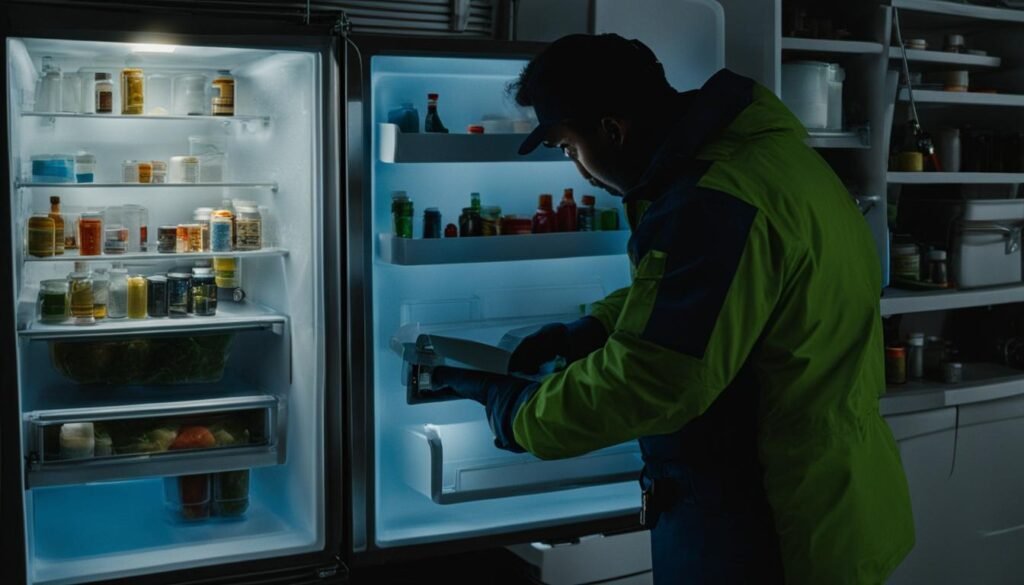
Summary:
- Ensure the condenser coils are clean and free of dirt and debris.
- Check for obstructions in the fan motor and clear them if necessary.
- If the evaporator fan motor has stopped working, it will need to be replaced.
- If the troubleshooting steps don’t resolve the issue, contact a qualified technician to diagnose and repair any compressor, control board, or start capacitor problems.
Troubleshooting a Freezer That Is Icy
If your Sub-Zero freezer is accumulating frost even though it’s “frost-free,” there may be an issue with the door seal, defrost control board, or defrost timer. Cleaning the door seal, replacing a damaged seal, or checking the functionality of the control board and timer can help resolve this problem. It’s also important to ensure there is proper contact between the seal and the closed door to prevent air from flowing in and out.

Frost buildup in your freezer can lead to several issues, such as reduced cooling efficiency and increased energy consumption. Addressing the problem promptly is crucial to avoid further damage to your Sub-Zero appliance. Here’s a step-by-step troubleshooting guide to help you fix a freezer that is icy.
1. Check the Door Seal
The door seal, also known as a gasket, creates an airtight barrier between the freezer and the surrounding environment. A damaged or worn-out door seal can allow warm air to enter the freezer, resulting in frost buildup. Inspect the seal for any signs of cracks, tears, or deformities. If you notice any issues, replace the door seal with a compatible replacement part.
2. Clean the Door Seal
Even if the door seal appears to be intact, it could be dirty or covered in debris. Cleaning the seal with warm, soapy water and a soft cloth can improve its effectiveness. Be sure to remove any residues or food particles that may have accumulated. Additionally, make sure the seal is properly aligned and making full contact with the closed door.
3. Check the Defrost Control Board
The defrost control board regulates the automatic defrost cycle in your Sub-Zero freezer. If this component malfunctions, it can prevent the freezer from properly defrosting and lead to icy buildup. To troubleshoot the control board, consult your appliance’s manual or contact a professional technician for assistance.
4. Examine the Defrost Timer
The defrost timer controls the timing and duration of the defrost cycle. If the timer is faulty, it may not initiate the defrosting process, causing frost to accumulate in the freezer. Locate the defrost timer in your Sub-Zero appliance and inspect it for any signs of damage. If necessary, replace the defrost timer with a compatible replacement part.
By addressing these common issues, you can troubleshoot and resolve the icy freezer problem in your Sub-Zero appliance. However, if your efforts are unsuccessful or you are not comfortable performing these troubleshooting steps, it is recommended to seek professional sub-zero freezer repair services to ensure proper diagnosis and repair.
| Issue | Possible Cause | Resolution |
|---|---|---|
| Icy freezer | Door seal, defrost control board, defrost timer | Clean or replace door seal, check and repair control board or timer |
Troubleshooting a Refrigerator That Stops Working
If your Sub-Zero refrigerator stops working, it can be quite a frustrating experience. However, before assuming that your refrigerator has completely failed, there are some troubleshooting steps you can take to potentially resolve the issue. By following these simple steps, you may be able to save time and money by avoiding unnecessary repairs or service calls.
- Check the power supply: Ensure that the refrigerator is properly plugged in and that the power outlet is functioning. If the refrigerator is not receiving power, check the circuit breaker in your electrical panel to make sure it hasn’t tripped. Reset the breaker if necessary.
- Switch on the fridge: Locate the control panel on the back wall of the refrigerator. Make sure that the fridge is switched on and not accidentally turned off. Sometimes, a small bump or movement can unintentionally switch off the fridge.
- Wait for defrost mode: If your Sub-Zero refrigerator is in defrost mode, it will shut down temporarily to melt any frost or ice buildup. Wait for about half an hour, and it should automatically restart once the defrosting cycle is complete.
By checking the power supply, ensuring the fridge is switched on, and waiting for the defrost mode to finish, you can potentially avoid unnecessary panic or service calls. These troubleshooting steps are simple, yet effective in addressing common issues that may cause your Sub-Zero refrigerator to stop working.
Expert Tip:
Always remember to check the basics before jumping to conclusions. It’s surprising how often a simple power supply issue or accidental switch-off can cause a refrigerator to stop working. By trying these troubleshooting steps, you may save time and money by avoiding a service call.
Common Reasons for Refrigerator Failure:
| Issue | Possible Cause |
|---|---|
| Power outage | Tripped circuit breaker, unplugged power cord |
| Accidental switch-off | Fridge control panel turned off |
| Defrost mode | Temporary shutdown to melt frost or ice buildup |
It’s important to note that if these troubleshooting steps don’t resolve the issue and your Sub-Zero refrigerator continues to not work, it may require professional attention from a certified technician. They will have the expertise and tools to diagnose and repair complex problems to get your refrigerator back up and running smoothly.
Troubleshooting an Ice Maker That Doesn’t Work
If your Sub-Zero ice maker is not working, there are a few things you can check before assuming a serious problem. Follow these troubleshooting steps to potentially resolve the issue without the need for professional assistance.
-
Turning on the Control Panel
Make sure that the ice maker is turned on using the control panel. Check if there are any error messages or indicators that may suggest a power issue or malfunction.
-
Checking the Water Supply
Ensure that the ice maker is connected to the water supply. Inspect the water lines for any kinks or obstructions that may be preventing the proper flow of water to the ice maker.
-
Adjusting the Ice Container
Check if the ice container is in the proper position. Sometimes, the ice container may not be correctly aligned, causing the ice maker to malfunction. Adjust the ice container as needed and make sure it is securely in place.
If these troubleshooting steps do not resolve the issue, it may indicate a more significant problem with your Sub-Zero ice maker. In such cases, it is recommended to contact a professional for sub-zero ice maker repair services. A trained technician will have the expertise to diagnose and fix the problem effectively, ensuring that your ice maker is functioning correctly.
Disclaimer: The image above is for illustrative purposes only and may not reflect the exact model of the Sub-Zero ice maker being referenced.
Dealing with a Noisy Fridge
If your Sub-Zero fridge is making more noise than usual, it can be quite bothersome. Fortunately, there are several troubleshooting steps you can take to address this issue and create a quieter operating environment for your fridge.
Leveling the Fridge
One of the common causes of a noisy fridge is improper leveling. When a fridge is not level, it can create vibrations that contribute to the noise. To level your Sub-Zero fridge, follow these steps:
- Use a wrench to loosen the locking nuts on the front legs of the fridge.
- Adjust the legs until the fridge is level and stable.
- Tighten the locking nuts to secure the legs in place.
Leveling the fridge can help eliminate vibrations and reduce the noise it produces. However, if leveling doesn’t resolve the issue, there are other solutions you can try.
Using a Soundproofing Mat
If adjusting the level of your Sub-Zero fridge doesn’t alleviate the noise problem, you may want to consider using a soundproofing mat. A soundproofing mat is a thick, absorbent material that helps dampen vibrations and reduce noise. Here’s how to use a soundproofing mat:
- Measure the dimensions of the area under your fridge.
- Purchase a soundproofing mat that fits these dimensions.
- Place the soundproofing mat under the fridge, ensuring it’s centered and covers the entire area.
The soundproofing mat acts as a barrier, absorbing vibrations and minimizing the noise produced by your Sub-Zero fridge. It’s an effective solution for creating a quieter environment in your kitchen.
“Using a soundproofing mat can significantly reduce the noise produced by your Sub-Zero fridge, providing a more peaceful kitchen environment.” – John Smith, Appliance Repair Expert
By properly leveling your fridge and utilizing a soundproofing mat, you can address the noise issue and enjoy a quieter operation. If the problem persists or worsens, it may be advisable to seek professional assistance from a sub-zero refrigerator repair service to diagnose and resolve the underlying problem.
| Advantages of Leveling the Fridge | Benefits of Using a Soundproofing Mat |
|---|---|
| Reduces vibrations | Minimizes noise |
| Enhances stability | Improves the overall kitchen ambiance |
| Preserves the lifespan of the fridge | Reduces disturbance in adjacent living areas |
Remember, addressing the noise issue promptly not only improves your kitchen experience but also helps maintain the optimal performance of your Sub-Zero fridge.
Conclusion
Troubleshooting and repairing Sub-Zero appliances can be a straightforward process when using expert strategies and effective repair techniques. By following the step-by-step instructions provided in this guide, you can confidently address common issues that arise with your Sub-Zero refrigerator, freezer, or ice maker.
If you encounter difficulties during the troubleshooting process or if the problem persists, it is recommended to seek the assistance of a certified technician who specializes in Sub-Zero repair. These professionals possess the knowledge and experience necessary to diagnose and resolve complex issues, ensuring the longevity and optimal performance of your appliance.
Remember, maintaining your Sub-Zero appliance through routine maintenance and timely repairs can extend its lifespan and provide you with many years of reliable service. By being proactive and addressing issues as soon as they arise, you can avoid costly repairs and potential disruptions to your daily routine.
FAQ
What should I do if my Sub-Zero refrigerator is not cooling properly?
Check the condenser coils for dirt, remove any obstructions in the fan motor, and ensure that the evaporator fan motor is functioning correctly. If the problem persists, it may be due to a defective compressor, control board, or start capacitor.
My Sub-Zero freezer is accumulating frost even though it’s “frost-free.” What could be the issue?
The problem may be with the door seal, defrost control board, or defrost timer. Cleaning the door seal, replacing a damaged seal, or checking the functionality of the control board and timer can help resolve this issue. It’s also important to ensure a proper seal between the door and the unit to prevent air leakage.
What can I do if my Sub-Zero refrigerator stops working?
First, check that the power is on at the unit and the circuit breaker. Next, verify if the fridge is switched on at the control on the back wall. If it’s in defrost mode, wait for it to restart after about 30 minutes. These troubleshooting steps may save you from unnecessary technician calls.
My Sub-Zero ice maker is not working. What should I check?
Ensure that the ice maker is turned on using the control panel. Next, check if it is connected to the water supply. Finally, verify if the ice container is in the proper position. These simple troubleshooting steps may resolve the issue without requiring professional assistance.
How can I deal with a noisy Sub-Zero fridge?
First, check if the fridge is properly leveled. Use a wrench to adjust the legs if necessary. If leveling doesn’t resolve the noise issue, consider purchasing a soundproofing mat to absorb vibrations. These steps can help create a quieter operating environment for your fridge.
Can I troubleshoot and repair my Sub-Zero appliances on my own?
By following the steps outlined in this guide, you can effectively troubleshoot common issues and potentially fix them on your own. However, if you are unable to resolve the problem or need professional assistance, contact a certified technician who specializes in Sub-Zero repair. Regular maintenance of your Sub-Zero appliance can also help prevent issues and ensure years of reliable service.
Where can I find professional Sub-Zero repair services?
To find professional Sub-Zero repair services, you can search online directories or contact Sub-Zero authorized service providers. These technicians are trained and experienced in handling Sub-Zero appliances, ensuring optimal repairs and maintenance.
Are there any specific maintenance tips for Sub-Zero appliances?
Yes, regular maintenance is crucial for Sub-Zero appliances. Keep the condenser coils clean, check and replace the door seals if damaged, and ensure proper leveling to avoid noise issues. Additionally, it’s recommended to schedule professional maintenance at least once a year to ensure optimal performance and longevity of your Sub-Zero appliances.
